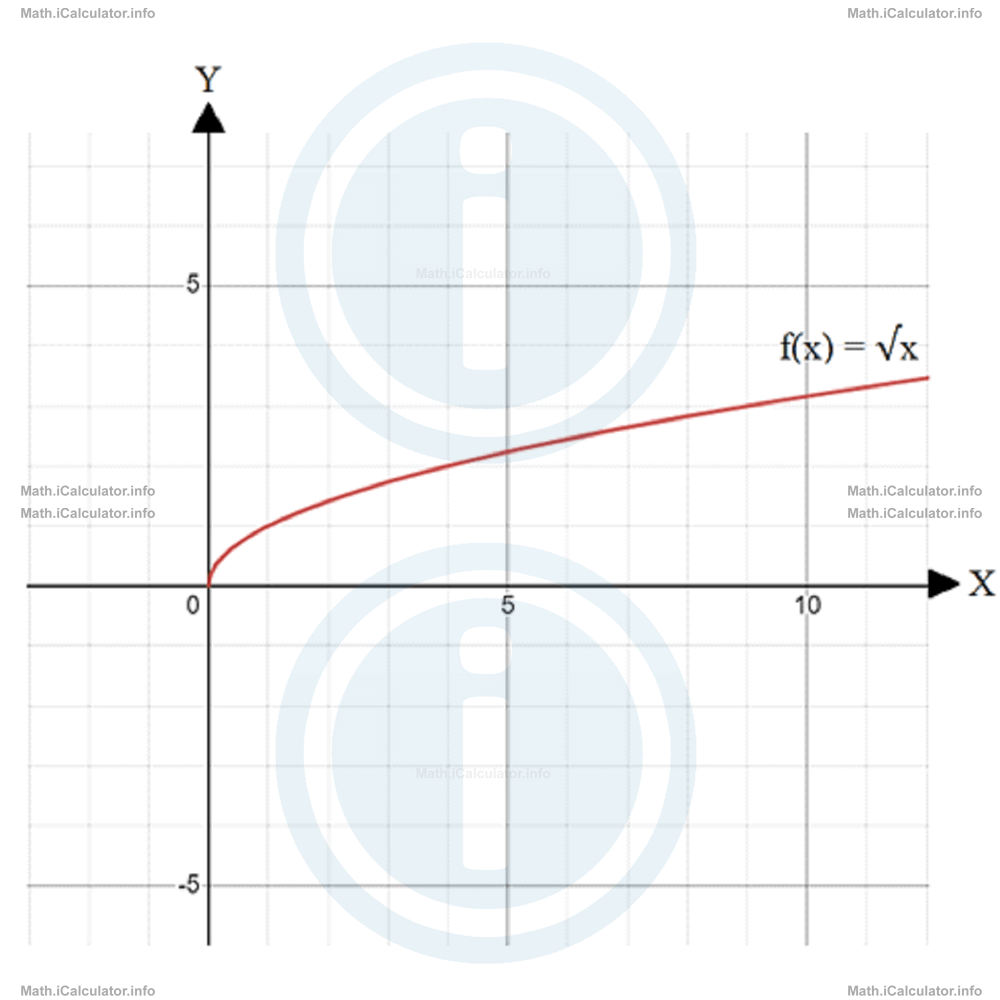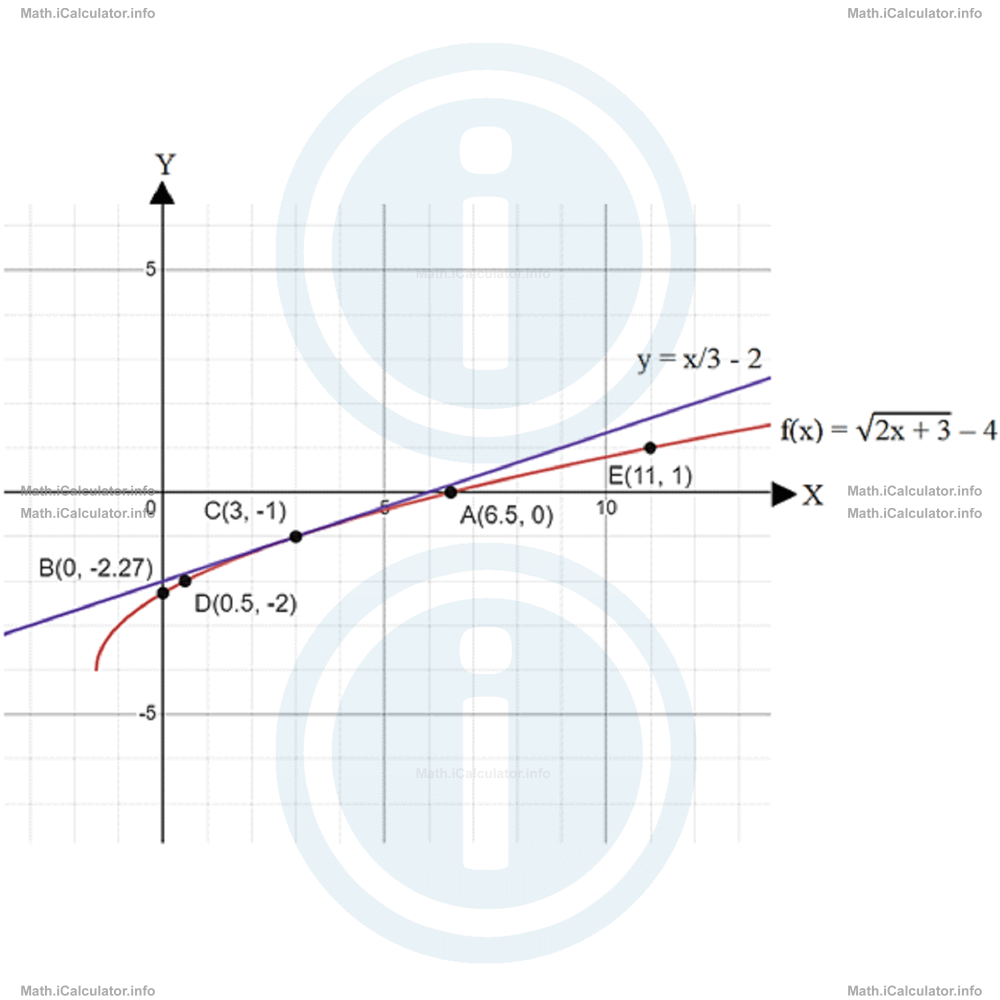Menu
Math Lesson 16.3.6 - Square Root Function
Please provide a rating, it takes seconds and helps us to keep this resource free for all to use
Welcome to our Math lesson on Square Root Function, this is the sixth lesson of our suite of math lessons covering the topic of Basic Functions, you can find links to the other lessons within this tutorial and access additional Math learning resources below this lesson.
Square Root Function
Another function we are going to discuss in this tutorial is the square root function. In the positive part of the horizontal axis this function it is the inverse of the corresponding quadratic function. However, the square root function is not defined in the negative part of the horizontal axis since the square root of negative numbers does not exist in the set of real numbers. If we consider the parent function of each of the two above types, we have
Thus, it is clear that the domain of the parent square root function is D = [0, + ∞).
Despite the fact that a square root contains two values, one positive and one negative, in the square root functions, we accept only the positive values because if we accept both, it would not be a function anymore, given that in functions, an x-value cannot have in correspondence two y-values. Therefore, the range of square root functions is also limited only to the positive region of the Y-axis. The figure below shows the graph of the parent square root function f(x) = √x.

It is clear that any constant added to the parent square root function above makes the graph shift vertically, while any coefficient preceding x when inserted inside the root or preceding the square root when inserted outside the root, stretches or compresses the graph.
The gradient m of the parent square root function f(x) = √x is
When the square root function is given in the form
the corresponding gradient m is
Again, we will make the proof of this formula when explaining derivatives.
Example 6
For the function
find:
- Domain and range
- Intercept(s) of the graph with the axes.
- Gradient at x = 3.
- The equation of tangent line at x = 3.
- Plot the graph of f(x) including any asymptote(s) and the tangent line found in (d).
Solution 6
- The domain of this function is obtained for 2x + 3 ≥ 0, given that the square root of a number cannot be negative. Thus, 2x + 3 ≥ 0Therefore, the domain is D = [-3/2, + ∞).
2x ≥ -3
x ≥ -3/2
Since the square root part is 0 or bigger, the value of f(x) is -4 or bigger. Therefore, the range is R = [-4, + ∞). - The x-intercept is obtained for f(x) = 0. Thus, 0 = √(2x + 3) - 4Hence, the x-intercept is at A(6.5, 0).
√(2x + 3) = 4
(√(2x + 3))2 = 42
2x + 3 = 16
2x = 13
x = 13/2
= 6.5
The y-intercept is obtained for x = 0. We havef(x) = √(2 ∙ 0 + 3) - 4Hence, the y-intercept is at B(0, -2.27).
= √3 - 4
= 1.73 - 4
= -2.27 - The gradient of the function f(x) is m = a/2√(ax + b)where a = 2 and b = 3. Thus, at x = 3 the gradient ism = 2/2√(2 ∙ 3 + 3)
= 2/2 ∙ √9
= 1/3 - The equation of the tangent line at any point (x, y) of a function f(x) is y = mx + nwhere m is the gradient of the function at that point. In the specific case, we have m = 1/3 and x = 3. Thus,f(x) = √(2 ∙ 3 + 3) - 4Hence, since the two lines have the same coordinates at the tangency point C(3, -1), we obtain
= √9 - 4
= 3 - 4
= -1-1 = 1/3 ∙ 3 + nThe equation of the tangent line at x = 3 therefore is
-1 = 1 + n
n = -2y = 1/3 x - 2 - To plot an accurate graph, we need some extra points besides the three points A, B and C we already know. Thus, for x = 1/2 (or 0.5), we have f(1/2) = √(2 ∙ 1/2 + 3) - 4Thus, another point of the graph is D(0.5, -2).
= √(1 + 3) - 4
= √4 - 4
= 2 - 4
= -2
Another easy point to identify from the graph is obtained for x = 11 becausef(11) = √(2 ∙ 11 + 3) - 4Hence, point E(11, 1) is another point of the graph.
= √(22 + 3) - 4
= √25 - 4
= 5 - 4
= 1
Summarizing everything found above and showing all points in the graph yields the following figure.
You have reached the end of Math lesson 16.3.6 Square Root Function. There are 8 lessons in this physics tutorial covering Basic Functions, you can access all the lessons from this tutorial below.
More Basic Functions Lessons and Learning Resources
Whats next?
Enjoy the "Square Root Function" math lesson? People who liked the "Basic Functions lesson found the following resources useful:
- Square Root Feedback. Helps other - Leave a rating for this square root (see below)
- Functions Math tutorial: Basic Functions. Read the Basic Functions math tutorial and build your math knowledge of Functions
- Functions Revision Notes: Basic Functions. Print the notes so you can revise the key points covered in the math tutorial for Basic Functions
- Functions Practice Questions: Basic Functions. Test and improve your knowledge of Basic Functions with example questins and answers
- Check your calculations for Functions questions with our excellent Functions calculators which contain full equations and calculations clearly displayed line by line. See the Functions Calculators by iCalculator™ below.
- Continuing learning functions - read our next math tutorial: Composite Functions
Help others Learning Math just like you
Please provide a rating, it takes seconds and helps us to keep this resource free for all to use
We hope you found this Math tutorial "Basic Functions" useful. If you did it would be great if you could spare the time to rate this math tutorial (simply click on the number of stars that match your assessment of this math learning aide) and/or share on social media, this helps us identify popular tutorials and calculators and expand our free learning resources to support our users around the world have free access to expand their knowledge of math and other disciplines.